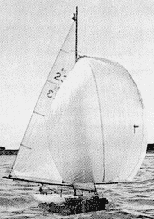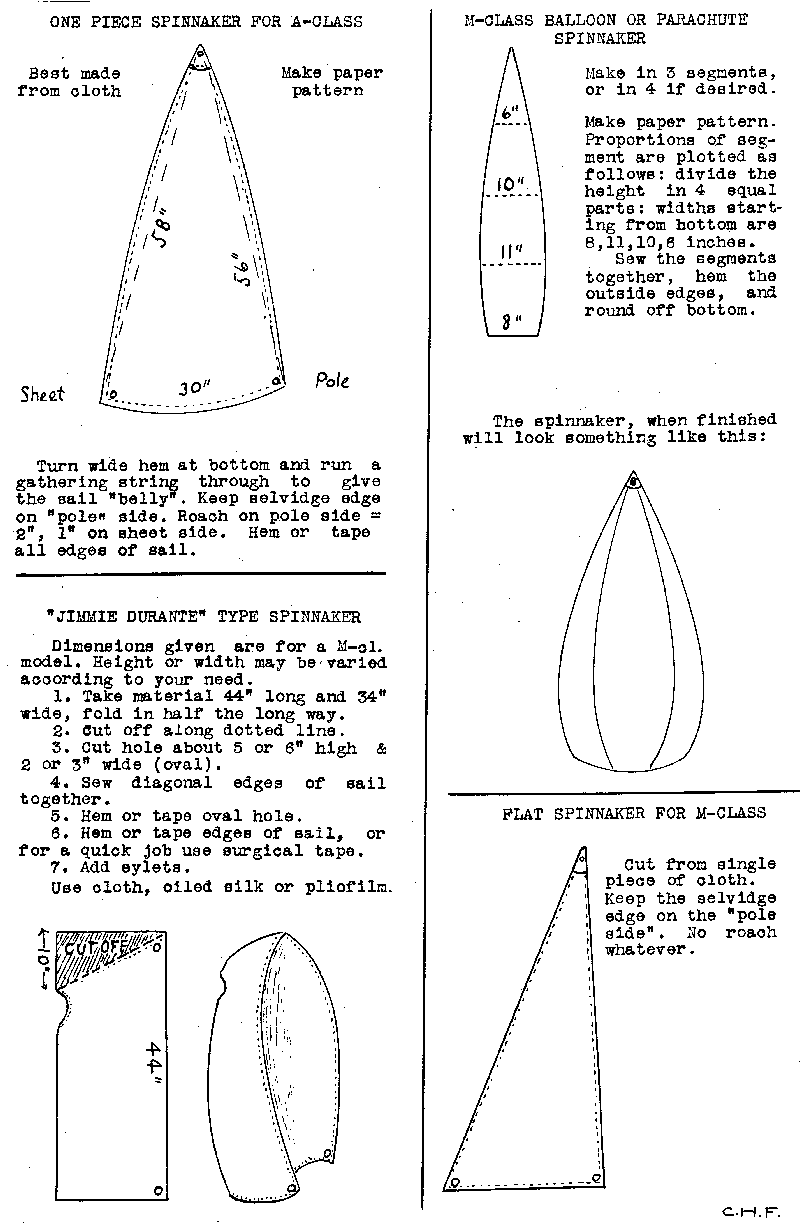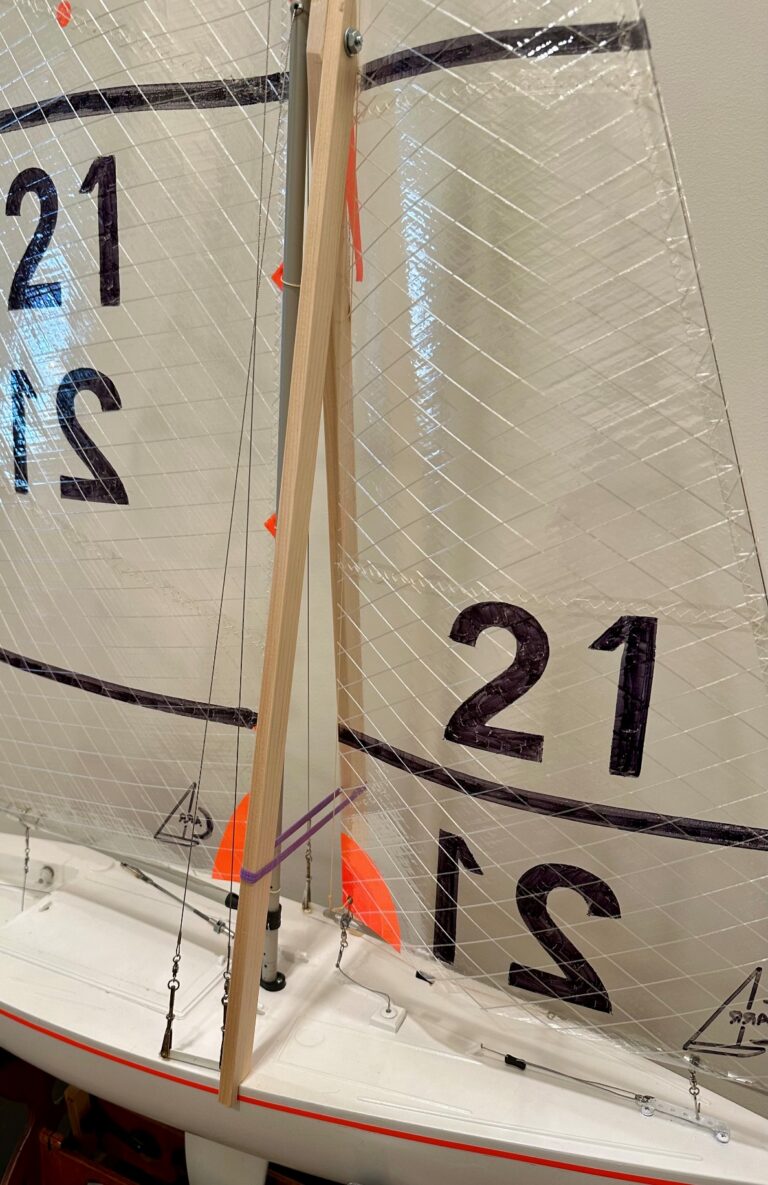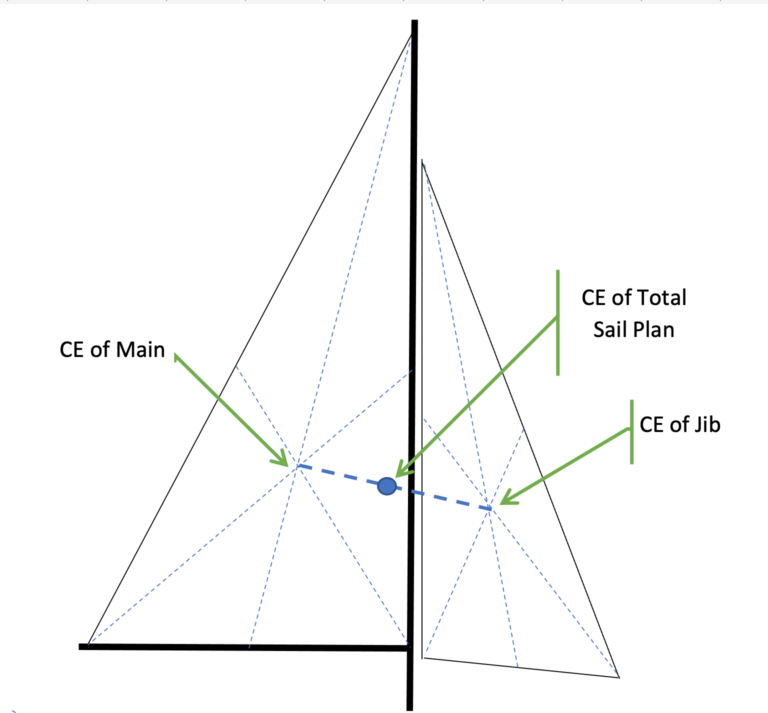by T.W. Houk and C.W. Farley

The proper use of a spinnaker adds speed and steadiness to a model yacht when running before the wind, and may also be used on a broad reach. When steady, unidirectional winds prevail, the spinnaker provides a relief from the monotony of sailing with the jib and mainsail only, to say nothing about the satisfying spectacle of a model yacht tearing along with a full, drawing, spinnaker. However, when the wind is light, the spinnaker is sometimes more a hindrance than a help.
The skipper must decide for himself when and when not to use a spinnaker. Remember, the spinnaker is a pulling and lifting sail, and if the wind tends to head your yacht, then the spinnaker will cause grief.
A spinnaker is always set on the opposite side to the mainsail. The spinnaker pole is carried slightly forward of the angle established by the main boom, and the spinnaker sheet is adjusted so the sail draws well and bellies out. Never set the spinnaker pole square with the beam of the yacht.
With the wind on the quarter, or abaft the beam, the run approaches a broad reach, and the pole is set still further forward than for a run, and the sheet hauled in accordingly.
Some skippers try and use a small flat spinnaker on a reach. This is a tricky business, and successful only with a steady wind. The spinnaker pole may touch the jib-stay when it is away forward, but the pole may not be belayed to anything at the forward end, by the rules.
The spinnaker pole is supported in various ways. The end nearest the mast is sometimes rigged in a sort of “floating position” and in other instances it is held by a fitting depending from the gooseneck. The outboard end of the pole is usually belayed by adjustable guys, for and aft. The spinnaker sheet may be led around the jibstay or forestay where it is of the balloon type, or abaft the headsail if it is small. The sheet is also adjustable by means of a sliding bowser.
In very light winds a topping-lift, running from the outboard end of the pole upward to the mast, will serve to belly out the sail and increase its pulling power. The forward guy, unhooked from its deck-eye will serve this purpose.
Use of Helm with Spinnaker
The turning effect of the large mainsail is cancelled out by the use of a small amount of helm, where no spinnaker is used. Where a large spinnaker is shipped, the amount of helm can be reduced considerably, with the rudder amidships, or nearly amidships.
Using the Vane Gear
When using a vane gear, spinnaker shipped, the vane can be set on the center-line of the yacht on a dead run. Where the run is made with the wind on the quarter, the vane is set one or two points off the centerline on the opposite side from the main boom.
Using the Braine Gear
The principle of the helm is the same as for vane gear. The crossed mainsheets are set equal, from one to three holes out from the center of the quadrant. With the wind off the quarter, set one of the crossed sheets one or two holes further out on the quadrant on the side opposite the main boom, which will give more leverage in an accidental jibe.
Choice of Spinnaker
The selection of the proper spinnaker (size or type) or the decision to use one, or not to use one on a given run, requires considerable thought. The behavior of yachts already started will be a valuable clue, both as to size and type of spinnaker to use to advantage. Note if these yachts run true, or if the wind veers or backs, or if there is a place where the broach. Sometimes it is necessary to start a yacht in a direction other than straight down the pond to avoid dead spots, eddies, or adverse wind currents.
If too small a spinnaker (or none at all) is used, the race may be lost through lack of speed. If too large a “bag” is shipped, the race may be lost because the boat is overpowered or broaches.
In deciding which spinnaker to ship, one must consider the capabilities of his opponent, the score of one’s yacht to date in the race, the portion of the race completed, and the behavior of other yachts using spinnakers. [Editor’s Note: The discussion that follows is based on the two-at-a-time match racing which was the standard mode of racing in the free-sailing era.]
With a comfortable lead in the scoring, and in strong winds of a steady nature, a large spinnaker may be chanced for the spectacle of the thing. When racing a known slow yacht, it is best to play safe use a small spinnaker. If the opposing yacht is known to be fast, a larger spinnaker should be chosen, unless it is reasonably certain the wind conditions predict that the fast yacht will broach, in which event a small spinnaker is set.
In very light winds of uniform direction, but slightly varying in velocity, a small spinnaker that remains full is better than a large one that alternately fills and collapses.
Although a yacht with a large spinnaker will almost always take the lead under such circumstances, a yacht with a small spinnaker will keep a steady course and pace. Each time a large spinnaker collapses a yacht will lose way, and a yacht with a small spinnaker will gain a few feet and will usually win by a comfortable margin.
If the wind is steady, and strong enough to keep a large spinnaker just full, without collapsing, it should be used. In a somewhat stronger breeze, where yachts with large spinnakers are broaching only occasionally, a large spinnaker is used against a fast boat, a small one against a slow boat.
In light shifting winds, use a spinnaker if your opponent does. If the wind is unfavorable and spinnakers have to be removed en route, he is in the same predicament as you are, unless your yacht fails to come ashore and his does. If your opponent uses a spinnaker where the wind is shifting much, it is folly, and you should not use one.
You will find in traveling around the country that in some localities spinnakers are used as a matter of course, while in other places their use is a rarity because of blanketed ponds, obstructions to the wind and poor sailing conditions. A good rule to adopt is: “Never use a spinnaker unless the wind condition warrants.”
Types of Spinnakers

Oiled silk is superior to most cloth fabrics, excepting when the weather is cold, in which case oiled silk gets brittle and does not allow bellying out in light airs. Pliofilm and adhesive tape may be used to construct a spinnaker in a few minutes, as the “Jimmie Durante” type, which seems to work as well as a carefully gored type. [The best modern material is a light grade of rip-stop nylon. Pliofilm was a thin sheet plastic. And Jimmie Durante, for the young ‘uns out there, was an entertainer celebrated for his nose, or “schnoz.” – Ed] Balloon or parachute types are made in segments or gored like an umbrella, sewed and taped together. Spinnakers made in one piece cut to a triangular shape are suitable for fluctuating winds or for close and broad reaching.
Holes in Spinnakers
Scientists are still quarreling about the efficiency of holes cut in spinnakers. Skippers are also divided in opinion. However, we have made two spinnakers from the same pattern, one with holes, one without, and can see no difference.
Spinnakers in Reaches
In broad reaches a comparatively flat spinnaker is used with the boom well forward. The principle of sheeting the spinnaker well inboard and having the pole away forward is to deflect the wind away from the mainsail onto the spinnaker, so the latter will not collapse when the wind gets too close abeam.
A dead-flat spinnaker is sometimes used on a close reach, with the pole touching the forestay. Some contend this makes it a reaching jib, in effect, but as long as the pole is not fastened to the deck at its forward end it is allowed by the rules. It is folly to use such a rig if the wind is unsteady — if it gets on the wrong side of the sail the spinnaker gets aback, and the yacht stalls or sails backward.



